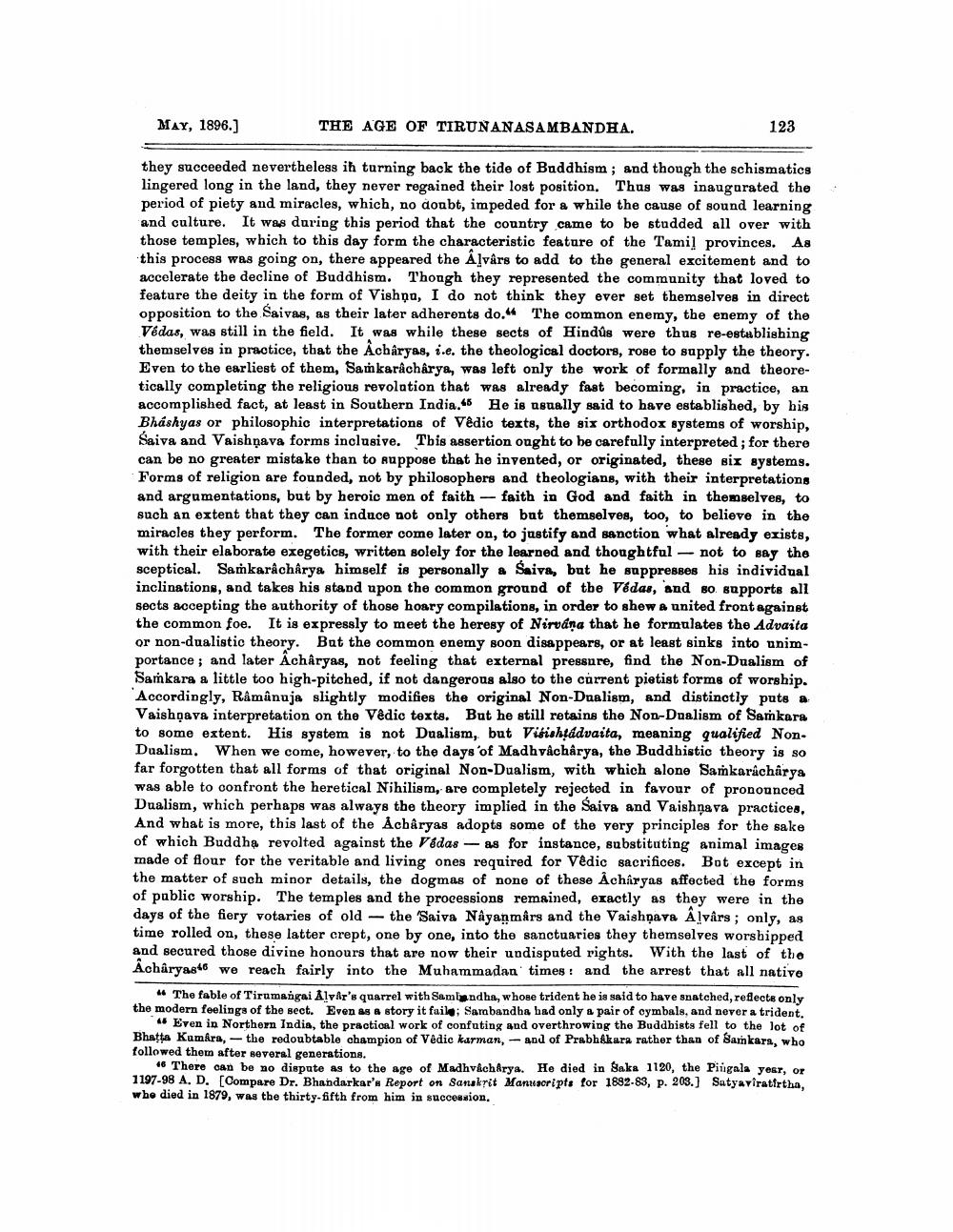________________
MAY, 1896.)
THE AGE OF TIRUNANASAMBANDHA.
123
they succeeded nevertheless ih turning back the tide of Buddhism ; and though the schismatics lingered long in the land, they never regained their lost position. Thus was inaugurated the period of piety and miracles, which, no doubt, impeded for a while the cause of sound learning and culture. It was during this period that the country came to be studded all over with those temples, which to this day form the characteristic feature of the Tamil provinces. As this process was going on, there appeared the Alvars to add to the general excitement and to accelerate the decline of Buddhism. Though they represented the community that loved to feature the deity in the form of Vishņa, I do not think they ever set themselves in direct opposition to the Saivas, as their later adherents do. The common enemy, the enemy of the Védas, was still in the field. It was while these sects of Hindus were thus re-establishing themselves in practice, that the Acharyas, i.e. the theological doctors, rose to supply the theory. Even to the earliest of them, Sankaracharya, was left only the work of formally and theoretically completing the religious revolution that was already fast becoming, in practice, an accomplished fact, at least in Southern India. He is Osually said to have established, by his Bhashyas or philosophic interpretations of Vedic texts, the six orthodox systems of worship, Saiva and Vaishnava forms inclusive. This assertion ought to be carefully interpreted; for there can be no greater mistake than to suppose that he invented, or originated, these six systems. Forms of religion are founded, not by philosophers and theologians, with their interpretations and argumentations, but by heroic men of faith - faith in God and faith in themselves, to such an extent that they can induce not only others but themselves, too, to believe in the miracles they perform. The former come later on, to justify and sanction what already exists, with their elaborate exegetics, written solely for the learned and thoughtful — not to say the sceptical. Samkarâchårya himself is personally & Saiva, but he suppresses his individual inclinations, and takes his stand upon the common ground of the Vedas, and so supports all sects accepting the authority of those hoary compilations, in order to show a united front against the common foe. It is expressly to meet the heresy of Nirvana that he formulates the Advaita or non-dualistic theory. But the common enemy soon disappears, or at least sinks into unimportance; and later Acharyas, not feeling that external pressure, find the Non-Dualism of Samkars a little too high-pitched, if not dangerous also to the current pietist forms of worship. Accordingly, Râmânuja slightly modifies the original Non-Dualism, and distinctly puts a Vaishọava interpretation on the Vedic texts. But he still retains the Non-Dualism of Samkara to some extent. His system is not Dualism, but Vitish advaita, meaning qualified NonDualism. When we come, however, to the days of Madhvacharya, the Buddhistic theory is so far forgotten that all forms of that original Non-Dualism, with which alone Samkaracharya was able to confront the heretical Nihilism, are completely rejected in favour of pronounced Dualism, which perhaps was always the theory implied in the Saiva and Vaishnava practices, And what is more, this last of the Acharyas adopts some of the very principles for the sake of which Buddha revolted against the Vedas - as for instance, substituting animal images made of flour for the veritable and living ones required for Vedic sacrifices. Bot except in the matter of such minor details, the dogmas of none of these Acharyas affected the forms of public worship. The temples and the processions remained, exactly as they were in the days of the fiery votaries of old - the "Saiva Nayanmårs and the Vaishnava Âlvârs; only, as time rolled on, these latter crept, one by one, into the sanctuaries they themselves worshipped and secured those divine honours that are now their undisputed rights. With the last of the Acharya846 we reach fairly into the Muhammadan times and the arrest that all native
* The fable of Tirumangai AlyAr's quarrel with Sambandha, whose trident he is said to have snatched, reflects only the modern feelings of the sect. Even as a story it faile; Sambandha bad only a pair of cymbals, and never a trident,
Even in Northern India, the practionl work of confuting and overthrowing the Buddhists fell to the lot of Bhatta KamAra, the redoubtable champion of Vedic karman, - and of PrabhAkara rather than of Bankars, who followed them after several generations.
16 There can be no dispute as to the age of Madhvach&rya. He died in Baka 1120, the Pingala year, or 1197-98 A. D. Compare Dr. Bhandarkar's Report on Sanskrit Manuscripts for 1892-83, p. 203.] Satyaviratirtha, who died in 1879, was the thirty-fifth from him in succession.




